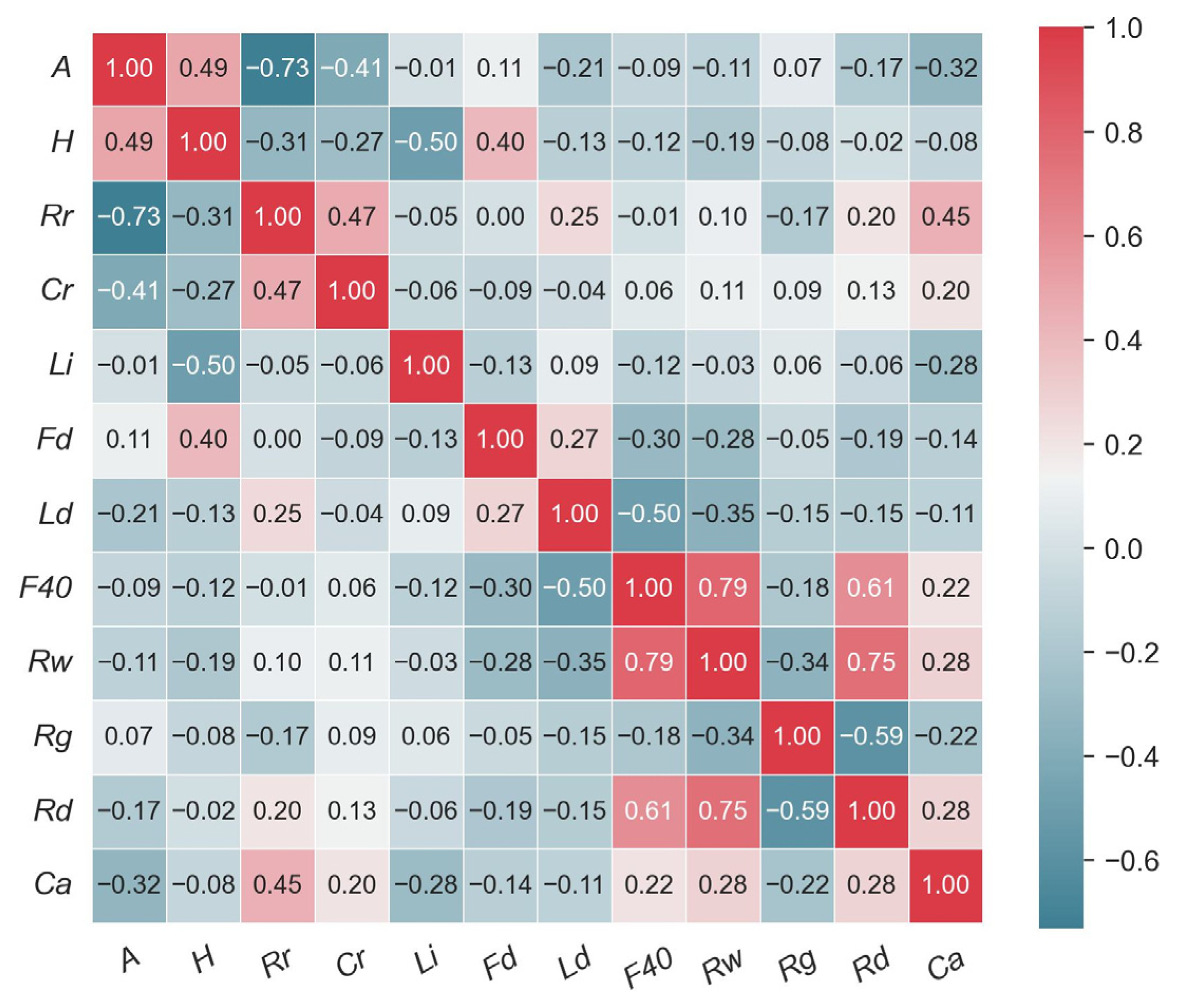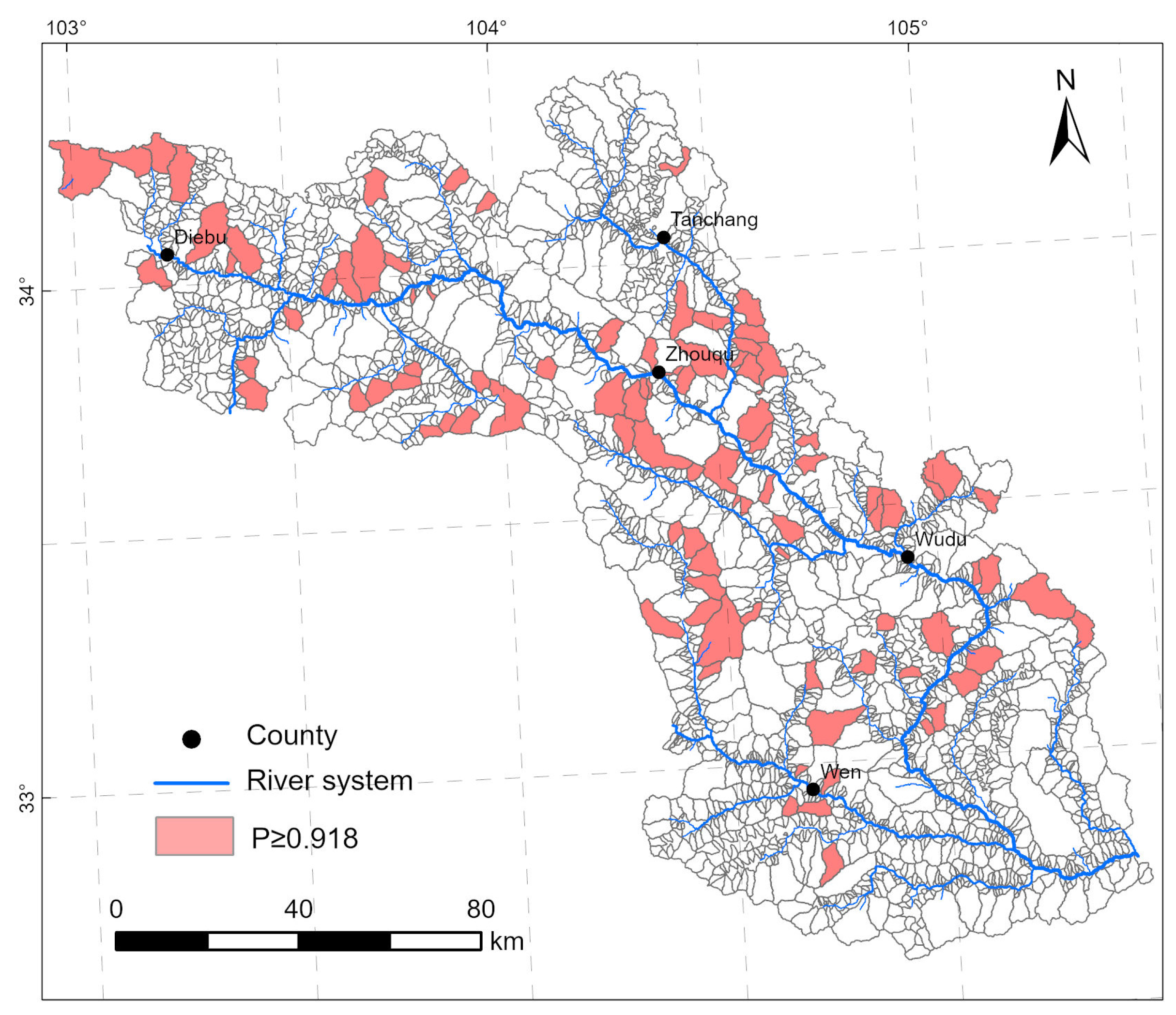Early Identification of River Blockage Disasters Caused by Debris Flows in the Bailong River Basin, China
Abstract
:1. Introduction
2. Data and Methods
2.1. Inventory of River Blocking Disasters
2.2. Impact Factors of Debris Flow-Induced River Blockages
2.3. Modeling Methods
2.3.1. Machine Learning Algorithms
2.3.2. Data Processing
2.3.3. Model Validation and Feature Importance
3. Results
4. Discussion
5. Conclusions
Author Contributions
Funding
Data Availability Statement
Acknowledgments
Conflicts of Interest
References
- Juez, C.; Garijo, N.; Hassan, M.A.; Nadal-Romero, E. Intraseasonal-to-Interannual Analysis of Discharge and Suspended Sediment Concentration Time-Series of the Upper Changjiang (Yangtze River). Water Resour. Res. 2021, 57, e2020WR029457. [Google Scholar] [CrossRef]
- Xiong, J.; Chen, H.; Tang, C.; Chen, M.; Chang, M.; Zhang, X.; Gong, L.; Li, N.; Shi, Q.; Li, M. Application of Remote Sensing Monitoring to the Spatiotemporal Variation in Debris Flow Activity in the Catastrophic Wenchuan Seismic Area. Catena 2023, 232, 107450. [Google Scholar] [CrossRef]
- Xia, X.; Jarsve, K.T.; Dijkstra, T.; Liang, Q.; Meng, X.; Chen, G. An Integrated Hydrodynamic Model for Runoff-Generated Debris Flows with Novel Formulation of Bed Erosion and Deposition. Eng. Geol. 2023, 326, 107310. [Google Scholar] [CrossRef]
- Zhao, Y.; Meng, X.; Qi, T.; Chen, G.; Li, Y.; Yue, D.; Qing, F. Extracting More Features from Rainfall Data to Analyze the Conditions Triggering Debris Flows. Landslides 2022, 19, 2091–2099. [Google Scholar] [CrossRef]
- Zhao, Y.; Meng, X.; Qi, T.; Li, Y.; Chen, G.; Yue, D.; Qing, F. AI-Based Rainfall Prediction Model for Debris Flows. Eng. Geol. 2022, 296, 106456. [Google Scholar] [CrossRef]
- Li, Y.; Zou, Q.; Hao, J.; Su, L. Risk Assessment of Debris Flows Along the Karakoram Highway (Kashgar-Khunjerab Section) in the Context of Climate Change. Int. J. Disaster Risk Sci. 2023, 14, 586–599. [Google Scholar] [CrossRef]
- Yu, B.; Yang, C.; Yu, M. Experimental Study on the Critical Condition of River Blockage by a Viscous Debris Flow. Catena 2022, 213, 106198. [Google Scholar] [CrossRef]
- Zou, Q.; Cui, P.; Jiang, H.; Wang, J.; Li, C.; Zhou, B. Analysis of Regional River Blocking by Debris Flows in Response to Climate Change. Sci. Total Environ. 2020, 741, 140262. [Google Scholar] [CrossRef] [PubMed]
- Zhao, Y.; Meng, X.; Qi, T.; Chen, G.; Li, Y.; Yue, D.; Qing, F. Estimating the Daily Rainfall Thresholds of Regional Debris Flows in the Bailong River Basin, China. Bull. Eng. Geol. Environ. 2023, 82, 46. [Google Scholar] [CrossRef]
- Zhao, Y.; Meng, X.; Qi, T.; Chen, G.; Li, Y.; Yue, D.; Qing, F. Modeling the Spatial Distribution of Debris Flows and Analysis of the Controlling Factors: A Machine Learning Approach. Remote Sens. 2021, 13, 4813. [Google Scholar] [CrossRef]
- Qing, F.; Zhao, Y.; Meng, X.; Su, X.; Qi, T.; Yue, D. Application of Machine Learning to Debris Flow Susceptibility Mapping along the China–Pakistan Karakoram Highway. Remote Sens. 2020, 12, 2933. [Google Scholar] [CrossRef]
- Tang, C.; Rengers, N.; van Asch, T.W.J.; Yang, Y.H.; Wang, G.F. Triggering Conditions and Depositional Characteristics of a Disastrous Debris Flow Event in Zhouqu City, Gansu Province, Northwestern China. Nat. Hazards Earth Syst. Sci. 2011, 11, 2903–2912. [Google Scholar] [CrossRef]
- Jiang, Z.; Fan, X.; Siva Subramanian, S.; Yang, F.; Tang, R.; Xu, Q.; Huang, R. Probabilistic Rainfall Thresholds for Debris Flows Occurred after the Wenchuan Earthquake Using a Bayesian Technique. Eng. Geol. 2021, 280, 105965. [Google Scholar] [CrossRef]
- Ma, C.; Wang, Y.; Hu, K.; Du, C.; Yang, W. Rainfall Intensity–Duration Threshold and Erosion Competence of Debris Flows in Four Areas Affected by the 2008 Wenchuan Earthquake. Geomorphology 2017, 282, 85–95. [Google Scholar] [CrossRef]
- Chen, N.S.; Zhang, Y.; Tian, S.F.; Deng, M.F.; Wang, T.; Liu, L.H.; Liu, M.; Hu, G.S. Effectiveness Analysis of the Prediction of Regional Debris Flow Susceptibility in Post-Earthquake and Drought Site. J. Mt. Sci. 2020, 17, 329–339. [Google Scholar] [CrossRef]
- Dang, C.; Cui, P.; Cheng, Z.L. The Formation and Failure of Debris Flow-Dams, Background, Key Factors and Model Tests: Case Studies from China. Environ. Geol. 2009, 57, 1901–1910. [Google Scholar] [CrossRef]
- Zhuang, J.Q.; Cui, P.; Ge, Y.G.; Yi-Ping, H.; Liu, Y.H.; Guo, X.J. Probability Assessment of River Blocking by Debris Flow Associated with the Wenchuan Earthquake. Int. J. Remote Sens. 2010, 31, 3465–3478. [Google Scholar] [CrossRef]
- Liu, J.; You, Y.; Chen, X.; Chen, X. Mitigation Planning Based on the Prediction of River Blocking by a Typical Large-Scale Debris Flow in the Wenchuan Earthquake Area. Landslides 2016, 13, 1231–1242. [Google Scholar] [CrossRef]
- Wang, L.; Chang, M.; Dou, X.; Ma, G.; Yang, C. Analysis of River Blocking Induced by a Debris Flow. Geofluids 2017, 2017, 1268135. [Google Scholar] [CrossRef]
- Chen, K.T.; Lin, C.H.; Chen, X.Q.; Hu, G.S.; Guo, X.J.; Shieh, C.L. An Assessment Method for Debris Flow Dam Formation in Taiwan. Earth Sci. Res. J. 2018, 22, 37–43. [Google Scholar] [CrossRef]
- Chen, K.T.; Chen, X.Q.; Niu, Z.P.; Guo, X.J. Early Identification of River Blocking Induced by Tributary Debris Flow Based on Dimensionless Volume Index. Landslides 2019, 16, 2335–2352. [Google Scholar] [CrossRef]
- Wang, J.; Hassan, M.A.; Saletti, M.; Yang, X.; Zhou, H.; Zhou, J. Experimental Study on the Mitigation Effects of Deflection Walls on Debris Flow Hazards at the Confluence of Tributary and Main River. Bull. Eng. Geol. Environ. 2022, 81, 354. [Google Scholar] [CrossRef]
- Stancanelli, L.M.; Lanzoni, S.; Foti, E. Propagation and Deposition of Stony Debris Flows at Channel Confluences. Water Resour. Res. 2015, 51, 5100–5116. [Google Scholar] [CrossRef]
- Zhao, Y.; Meng, X.; Qi, T.; Qing, F.; Xiong, M.; Li, Y.; Guo, P.; Chen, G. AI-Based Identification of Low-Frequency Debris Flow Catchments in the Bailong River Basin, China. Geomorphology 2020, 359, 107125. [Google Scholar] [CrossRef]
- Patton, P.C. Drainage Basin Morphometry and Floods. In Flood Geomorphology; John Wiley & Sons: Hoboken, NJ, USA, 1988; pp. 51–64. [Google Scholar]
- Alqahtani, F.; Qaddah, A.A. GIS Digital Mapping of Flood Hazard in Jeddah–Makkah Region from Morphometric Analysis. Arab. J. Geosci. 2019, 12, 199. [Google Scholar] [CrossRef]
- Patton, P.C.; Baker, V.R. Morphometry and Floods in Small Drainage Basins Subject to Diverse Hydrogeomorphic Controls. Water Resour. Res. 1976, 12, 941–952. [Google Scholar] [CrossRef]
- Potter, P.E. A Quantitative Geomorphic Study of Drainage Basin Characteristics in the Clinch Mountain Area, Virginia and Tennessee. V.C. Miller. J. Geol. 1957, 65, 112–113. [Google Scholar] [CrossRef]
- Strahler, A.N. Quantitative Analysis of Watershed Geomorphology. Eos Trans. Am. Geophys. Union 1957, 38, 913–920. [Google Scholar] [CrossRef]
- Malik, A.; Kumar, A.; Kandpal, H. Morphometric Analysis and Prioritization of Sub-Watersheds in a Hilly Watershed Using Weighted Sum Approach. Arab. J. Geosci. 2019, 12, 118. [Google Scholar] [CrossRef]
- Sreedevi, P.D.; Subrahmanyam, K.; Ahmed, S. The Significance of Morphometric Analysis for Obtaining Groundwater Potential Zones in a Structurally Controlled Terrain. Environ. Geol. 2005, 47, 412–420. [Google Scholar] [CrossRef]
- Gong, Y.; Xing, X.; Li, Y.; Zhu, C.; Li, Y.; Yan, J.; Le, H.; Li, X. Insights into the Movement and Diffusion Accumulation Characteristics of a Catastrophic Rock Avalanche Debris—A Case Study. Remote Sens. 2023, 15, 5154. [Google Scholar] [CrossRef]
- Gong, Y.; Yao, A.; Li, Y.; Li, Y.; Li, Y.; Sun, Y. Model Test Study on Sliding-Toppling Composite Deformation Evolution of Anti-Dip Layered Rock Slope. Bull. Eng. Geol. Environ. 2023, 82, 194. [Google Scholar] [CrossRef]
- Chawla, N.V.; Japkowicz, N.; Drive, P. Editorial: Special Issue on Learning from Imbalanced Data Sets Aleksander Ko l Cz. ACM Sigkdd Explor. Newsl. 2004, 6, 1–6. [Google Scholar] [CrossRef]
- Chawla, N.V.; Bowyer, K.W.; Hall, L.O.; Kegelmeyer, W.P. SMOTE: Synthetic Minority over-Sampling Technique. J. Artif. Intell. Res. 2002, 16, 321–357. [Google Scholar] [CrossRef]
- Guyon, I.; Weston, J.; Barnhill, S.; Vapnik, V. Gene Selection for Cancer Classification Using Support Vector Machines. Mach. Learn. 2002, 46, 389–422. [Google Scholar] [CrossRef]
- Li, X.; Wang, Y.; Basu, S.; Kumbier, K.; Yu, B. A Debiased MDI Feature Importance Measure for Random Forests. In Proceedings of the 33rd Conference on Neural Information Processing Systems (NeurIPS 2019), Vancouver, BC, Canada, 26 June 2019. [Google Scholar]
- Glade, T. Linking Debris-Flow Hazard Assessments with Geomorphology. Geomorphology 2005, 66, 189–213. [Google Scholar] [CrossRef]
- Jakob, M.; Bovis, M.; Oden, M. The Significance of Channel Recharge Rates for Estimating Debris-Flow Magnitude and Frequency. Earth Surf. Process. Landf. 2005, 30, 755–766. [Google Scholar] [CrossRef]
- Huang, C.; Sun, Y.; An, Y.; Shi, C.; Feng, C.; Liu, Q.; Yang, X.; Wang, X. Three-Dimensional Simulations of Large-Scale Long Run-out Landslides with a GPU-Accelerated Elasto-Plastic SPH Model. Eng. Anal. Bound. Elem. 2022, 145, 132–148. [Google Scholar] [CrossRef]








| No. | Factors | Abbr. | Unit | Data and Methods |
|---|---|---|---|---|
| 1 | Basin area | A | km2 | DEM and GIS analysis |
| 2 | Basin height difference | H | m | DEM and GIS analysis |
| 3 | Channel relief ratio | Rr | / | DEM and GIS analysis |
| 4 | Circularity ratio | Cr | / | DEM and GIS analysis |
| 5 | Landslide density | Ld | / | Remote sensing interpretation and GIS analysis |
| 6 | Fault density | Fd | / | GIS analysis |
| 7 | Lithology index | Li | / | GIS analysis |
| 8 | Annual average frequency of daily rainfall >40 mm | F40 | times/yr | Rainfall data and GIS analysis |
| 9 | River width | Rw | m | Remote sensing interpretation and GIS analysis |
| 10 | River discharge | Rd | m3/s | Hydrological observation data |
| 11 | River gradient | Rg | / | Remote sensing interpretation and GIS analysis |
| 12 | Confluence angle | Ca | ° | Remote sensing interpretation and GIS analysis |
Disclaimer/Publisher’s Note: The statements, opinions and data contained in all publications are solely those of the individual author(s) and contributor(s) and not of MDPI and/or the editor(s). MDPI and/or the editor(s) disclaim responsibility for any injury to people or property resulting from any ideas, methods, instructions or products referred to in the content. |
© 2024 by the authors. Licensee MDPI, Basel, Switzerland. This article is an open access article distributed under the terms and conditions of the Creative Commons Attribution (CC BY) license (https://creativecommons.org/licenses/by/4.0/).
Share and Cite
Zeng, J.; Zhao, Y.; Zheng, J.; Zhang, Y.; Shi, P.; Li, Y.; Chen, G.; Meng, X.; Yue, D. Early Identification of River Blockage Disasters Caused by Debris Flows in the Bailong River Basin, China. Remote Sens. 2024, 16, 1302. https://doi.org/10.3390/rs16071302
Zeng J, Zhao Y, Zheng J, Zhang Y, Shi P, Li Y, Chen G, Meng X, Yue D. Early Identification of River Blockage Disasters Caused by Debris Flows in the Bailong River Basin, China. Remote Sensing. 2024; 16(7):1302. https://doi.org/10.3390/rs16071302
Chicago/Turabian StyleZeng, Jianjun, Yan Zhao, Jiaoyu Zheng, Yongjun Zhang, Pengqing Shi, Yajun Li, Guan Chen, Xingmin Meng, and Dongxia Yue. 2024. "Early Identification of River Blockage Disasters Caused by Debris Flows in the Bailong River Basin, China" Remote Sensing 16, no. 7: 1302. https://doi.org/10.3390/rs16071302
APA StyleZeng, J., Zhao, Y., Zheng, J., Zhang, Y., Shi, P., Li, Y., Chen, G., Meng, X., & Yue, D. (2024). Early Identification of River Blockage Disasters Caused by Debris Flows in the Bailong River Basin, China. Remote Sensing, 16(7), 1302. https://doi.org/10.3390/rs16071302










